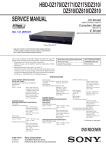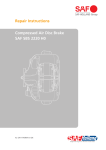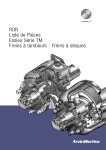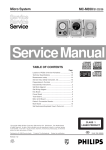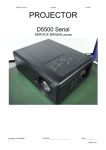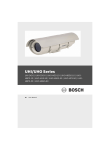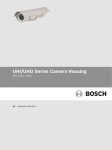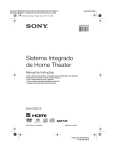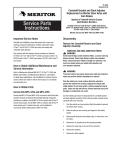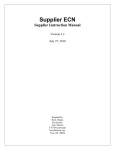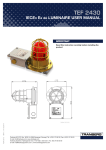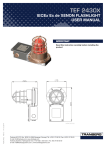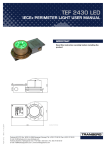Download DX Air Disc Brake DX series of disc brakes
Transcript
an ArvinMeritor brand Maintenance manual no. MM-1147 DX Air Disc Brake DX series of disc brakes Issued 06/2003 - 2nd Edition Service Notes Before You Begin This publication provides installation and maintenance procedures for the DX Air Disc Brake. The information contained in this publication was current at the time of printing and is subject to revision without notice or liability. You must understand all procedures and instructions before you begin maintenance and service procedures. Access Information on ArvinMeritor's Web Site Additional maintenance and service information for ArvinMeritor's commercial vehicle systems component lineup is also available at www.arvinmeritor.com. To access information, click on Products & Services/Tech Library Icon/HVS Publications. The screen will display an index of publications by type. You must follow your company's maintenance and service guidelines. You must use special tools, when required, to avoid serious personal injury and damage to components. Meritor uses the following notations to alert the user of possible safety issues and to provide information that will help to prevent damage to equipment and components. WARNING A WARNING indicates a procedure that you must follow exactly to avoid serious personal injury. CAUTION A CAUTION indicates a procedure that you must follow exactly to avoid damaging equipment or components. Serious personal injury can also occur. NOTE: A note indicates an operational, procedure or instruction that is important for proper service. A NOTE can also supply information that will help to make service quicker and easier. This symbol indicates that you must tighten fasteners to a specific torque. Information contained in this publication was in effect at the time the publication was approved for printing and is subject to change without notice or liability. ArvinMeritor Commercial Vehicle Systems reserves the right to revise the information presented to discontinue the production of parts described at any time. 2 ArvinMeritor DX Air Disc Brake Contents pg. 05 06 06 Section 1: Description General description Brake pad wear indicator 07 Section 2: Introduction 08 10 12 13 14 15 Exploded view - Pre March 2001 production Exploded view - Post March 2001 production Operating principles Automatic self-adjuster mechanism Automatic clearance compensation Thrust plate 17 Section 3: Maintenance 18 19 20 21 21 24 25 25 26 28 31 32 34 36 38 38 39 Maintenance operations Maintenance intervals A - Pad Replacement B - Manual Adjustment C - Rotor Inspection D - Automatic Adjuster Operating Tests E - Checking Slide Pin Bush Wear F - Brake Slide Pin Checks on vehicle Brake Servicing on bench G - Disassembly of Actuating System H - Slide Pin & Bushing Replacement I - Actuating Piston Seal Boot Replacement J - Saddle Replacement K - Eccentric Shaft & Cover Plate Replacement L - Stabiliser Bar Replacement M -Lever Replacement N - Thrust Plate Centering in Saddle O - Re-assembly of brake unit on vehicle and pad refitting 41 Section 4: Torque chart 42 Torque Chart, Special tools, Sealants 43 Section 5: Troubleshooting 44 Troubleshooting 47 Section 6: Service tools ArvinMeritor DX Air Disc Brake 3 Terms used in this manual Manufacturer: ARVINMERITOR CVS Manual: Maintenance manual no. MM-1147 Device: Air disc brake, DX series Technician: Qualified personnel working on brake maintenance and servicing. 4 Warranty Warranty applies to the air disc brake installed on vehicles for which it was designed. Warranty is void in the following cases: • Improper use of the vehicle on which the air disc brake is installed (usage conditions, overloading etc.) • Tampering with vehicle components that may affect brake performance. • Use of non-original spare parts. Maintenance and servicing: Maintenance and servicing refer to periodical checks and/or replacement of device parts or components. It also refers to the determining of the cause of a malfunction in order to restore the initial operating conditions. • Improper installation, adjustment, repair or modification. Operator: Any person who will use the device as part of a more complex device. Further information on warranty conditions may be obtained directly from the manufacturer or by referring to the ArvinMeritor web site www.arvinmeritor.com ArvinMeritor DX Air Disc Brake • Poor or improper maintenance (including consumables other than those specified). Description 1 pg. 06 06 General description Brake pad wear warning indicator (PWWI) ArvinMeritor DX Air Disc Brake 5 1 Description General description The ArvinMeritor CVS DX series of air disc brakes is a family of high performance, low weight, high efficiency brakes designed for trucks, coaches, buses and other commercial vehicles requiring between 10,000 and 23,000 Nm of braking torque at each wheel. Clamping force is produced by a globular cast iron caliper located above the rotor and housing two lining pads. The pads are pushed against the rotor by a dual piston actuating block connected to an eccentric shaft, which is in turn driven by a lever operated by a standard air actuator (air chamber). The caliper is carried on a saddle which is a fixed support bolted to the axle flange. Equalised clamping action both on the inner and outer pads is generated by allowing the caliper to float on the two slide pins fixed to the saddle. Clamping force generated by the primary actuation is applied to the inner pad, which forces it into contact with the rotor. Reactive force through the caliper body applies equal clamping force to the outer pad applying a balanced clamping force to the rotor. The slide pins also allow the caliper to freely position itself on the saddle to compensate for the reduction in lining pad thickness due to wear. An automatic self-adjuster mechanism is incorporated in order to maintain constant clearance between pads and rotor. The automatic adjuster operates on each clamping action to sense excessive pad-rotor clearance, and reduces excessive clearance by a fixed proportion with each actuation. For brake adjustment and new lining installation, the brake incorporates provision for manual adjustment, easily performed by using a standard hexagonal wrench. Brake actuation can be either clockwise or counter clockwise, depending on how the air actuator has been installed on brake unit. 6 ArvinMeritor DX Air Disc Brake Regardless of which side the brake unit is installed on vehicle, the brake is referred to as: RIGHT when actuation is clockwise - Fig. 2-2 a) and b) LEFT when actuation is counter clockwise - Fig. 2-2 c) and d) Clockwise actuation - Fig. 2-2 a) and b) - will always require left-hand threaded adjuster sleeves and pistons (actuation pistons marked on the bottom with the letter L) and its related right housing (R.H.). The opposite applies for brakes with counter clockwise actuation - Fig. 2-2 c) and d). Brake pad wear warning indicator Brakes can have different types of pad wear warning indicators (PWWI) according to vehicle manufacturer’s requirements. Follow vehicle manufacturer’s instructions for proper installation and connecting procedures. NOTE: Parts shown refer to standard configuration and may differ according to brake version and model. Use data on identification label (40) to order proper spare parts. Identification label (40) See the identification label attached on brake for suitable spare part and note down all spare part data indicated. Ref. 1 2 3 4 5 Description Brake Identification Number (ArvinMeritor ) Manufacturing Date Brake Identification Number (Customer) Brake Serial Number ArvinMeritor Logo Introduction 2 pg. 08 09 10 11 12 13 14 15 Exploded view - Pre March 2001 production Parts list Exploded view - Post March 2001 production Parts list Operating principles Automatic self-adjuster mechanism Automatic clearance compensation Thrust plate ArvinMeritor DX Air Disc Brake 7 Exploded view Pre March 2001 production 8 ArvinMeritor DX Air Disc Brake Parts list Pre March 2001 production Ref 1 2 3 4 5 6 7 8 9 10 11 12 13 14 15 16 17 18 19 20 21 22 23 Description Stabiliser bar retaining pin Pin clip Caliper Anti-rattle spring Stabiliser bar Cover plate gasket Eccentric shaft Cover plate Cover plate screws Eccentric shaft seal Eccentric shaft seal boot Clamp bolt (lever) Lever Clamp bolt nut (lever) Eccentric shaft bearing unit End plate gasket Slide pin bushing Eccentric shaft support bearing Actuation block Damping spring Snap ring Bevel gear / torque limiter Adjustment box ** (preinstalled unidirectional bearing) Q.ty 1 1 1 2 1 1 1 1 2 1 1 1 1 1 2 1 2 1 1 2 2 1 1 Ref 24 25 26 27 28 29 30 31 32 33 34 35 36 37 38 39 40 41 42 43 44 45 46 47 48 Description Damping ring Compression spring Air actuator end plate and bracket Flathead screw (end plate screw) End plate cap Plug (of adjuster port) Copper washer Hexagonal head screw (end plate screw) Adjuster device screw Adjuster gear segment Adjuster sleeve gear * Slide pin protective cap Adjuster sleeve ** Slide pin locking screw Actuating piston ** Slide pin Identification label Slide pin seal boot Actuating piston seal boot Roll pin Thrust plate Saddle Actuating piston screw Brake pads Brake pad wear indicator (if fitted) Q.ty 2 1 1 2 1 1 1 4 1 1 2 2 2 2 2 2 1 2 2 2 1 1 2 2 1 * Gear is shown separately since it is an integral part with adjuster screw. ** These components are different according to actuation direction (clockwise or counter – clockwise) (Fig. 2-2). ArvinMeritor DX Air Disc Brake 9 Exploded view Post March 2001 production 10 ArvinMeritor DX Air Disc Brake Parts list Post March 2001 production Ref 1 2 3 4 5 6 7 8 9 12 13 15 17 18 19 20 21 22 23 24 25 26 27 Description Stabiliser bar retaining pin Pin clip Caliper Anti-rattle spring Stabiliser bar Cover plate gasket Eccentric shaft Cover plate housing Cover plate screws Clamp bolt (lever) Lever Eccentric shaft bearing unit Slide pin bushing Eccentric shaft support bearing Actuation block Damping spring Snap ring Bevel gear / torque limiter Adjustment box ** (preinstalled unidirectional bearing) Damping ring Compression spring Air actuator end plate and bracket (shape may vary due to brake part number) End plate screws (style may vary due to brake part number) Q.ty 1 1 1 2 1 1 1 1 2 1 1 2 2 1 1 2 2 1 1 2 1 1 Ref 28 29 30 32 33 34 35 36 37 38 39a 39b 40 41 42 43 44 45 46 47 48 49 50 51 Description End plate cap Plug (of adjuster port) Copper washer Adjuster device screw Adjuster gear segment Adjuster sleeve gear * Slide pin protective cap Adjuster sleeve ** Slide pin locking screw (long) Actuating piston ** Slide pin (to suit long locking screw) Slide pin (to suit short locking screw) Identification label Slide pin seal boot Actuating piston seal boot Roll pin Thrust plate Saddle Actuating piston screw Brake pads Brake pad wear indicator (if fitted) Cover plate eccentric shaft seal Eccentric shaft seal Slide pin locking screw (short) Q.ty 1 1 1 1 1 2 2 2 1 2 1 1 1 2 2 2 1 1 2 2 1 1 1 1 6 * Gear is shown separately since it is an integral part with adjuster screw. ** These components are different according to actuation direction (clockwise or counter – clockwise) (Fig. 2-2). ArvinMeritor DX Air Disc Brake 11 2 Introduction Installation configuration A B C D Fig. 2.2 Operating principles Actuation Linear force from the air actuator (air chamber) is converted by lever action to rotary torque on the main eccentric shaft. Rotation of the shaft, supported by two roller bearings, causes the block to move towards the inside of the caliper. The ratio between the air actuator force and force on rotor is between 12,5 and 16,2 depending on brake model. All radial loads in the eccentric shaft are absorbed by two supporting roller bearings maintaining an efficiency of around 95% because of total absence of sliding friction in the system. 12 ArvinMeritor DX Air Disc Brake Clamping The caliper assembly is free to float on the slide pins attached to the saddle. This exerts clamping force on the inner pad and determines a reaction through the caliper body, ensuring that both pads are loaded onto the rotor by an equal force. 2 Introduction Automatic self-adjuster mechanism Fig. 2.3 Automatic self-adjuster mechanism Ref 1 2 3 4 5 6 7 Description Actuating piston Adjuster sleeve gear Eccentric shaft Actuation block Bevel gear Box (adjuster gear train) Adjuster gear segment ArvinMeritor DX Air Disc Brake 13 2 Introduction Automatic self adjuster mechanism (clearance compensation) This mechanism, located inside the caliper, allows control of clearance caused by continuous wear of the brake pads. The action is automatic and occurs during normal brake application. Clearance compensation is performed as indicated in the following four steps. Step 1 (actuation of eccentric shaft) a) Actuating lever moves and eccentric shaft rotates. b) Block lifts and begins to move forward, carrying the adjuster sleeves and pistons with it (Fig. 2-4). Step 1 Fig. 2.4 c) Eccentric shaft A begins turning within the gear plate segment, eliminating clearance “h” between the adjuster gear section slot B and the shaft integral tab sides (Fig. 2-5). Step 2 C Step 2 (clearance compensation device) d) Adjuster gear segment begins to turn causing the rotation of bevel gear adjuster C (Fig. 2-5). B e) Bevel gear rotation causes the adjuster shaft to rotate by means of the ball torque limiter and the rotation is transmitted to the box central gear through the unidirectional bearing. f) Central gear rotation, through the box gear train, causes the 2 adjuster sleeves to rotate. h A Fig. 2.5 At this stage, depending on the amount of wear of the brake pads, one of the following two conditions will occur: Condition A: No adjustment is required as clearance between pads and rotor is correct. Condition B: Adjustment is required as clearance between pads and rotor is excessive. Step 3 (Condition A) g) At this point, when the adjusters begin to turn, the pads contact the rotor before the sleeves begin to turn and clamping force F (braking) begins to build up. Step 3A Fig. 2.6 h) Clamping force generates friction in the screw threads between the adjuster sleeves B and pistons A, and friction under the flanged head of the adjuster sleeves (Fig. 2-6). 14 ArvinMeritor DX Air Disc Brake 2 Introduction i) The friction build-up prevents rotation of the adjuster sleeves whilst the torque limiter allows the adjuster shaft to rotate with respect to the bevel gear. The adjuster drive train is locked by the friction in the system and no adjustment takes place. The main gear turns but does not transmit motion due to the torque limiter blocking. Step 3 (Condition B) j) During the first stroke stage, before the pads come into contact with the rotor, the adjuster sleeves are turned by the gear box. k) Sleeve rotation, due to the threaded coupling with pistons, causes pistons to be unscrewed. This determines the length ‘L’ of the extracted part of the pistons to increase and the pads approaching stroke towards the rotor to reduce (Fig. 2-7). Step 3B Fig. 2.7 i) When the pads come into contact with the rotor the conditions mentioned above in step 3 A (g-i) are repeated, thus halting the movement. Step 4 (Brakes released) l) When the brake pedal is released, pressure is discharged from the air actuator and the brake actuating lever returns to its rest position pulled by the returning action of the internal air actuator spring. The eccentric shaft and the adjuster gear segment rotate in reverse direction together with the bevel gear. Step 4 Fig. 2.8 m) The unidirectional bearing free-wheels without transmitting motion to the gear housing, thus avoiding brake adjustment. The relative piston / sleeve adjustment position does not vary. Therefore, clearance compensation of pre-existing rotor and pads remains unchanged. (Fig. 2-8). Damping Compression springs are mounted in front of and behind the gearbox in order to dampen vibration caused by vehicle movement. This prevents induced vibrations from occurring, which could modify the clearance setting between rotor and pads (Fig. 2-9). A A A Thrust plate An important feature of the DX family of brakes is the setting of the thrust plate within the saddle abutments. Although this is factory set and provided the 2 locking screws are not removed from the thrust plate, no resetting should be necessary. Damping Fig. 2.9 However should the screws become disturbed a procedure for resetting should be followed: see maintenance Section N “Thrust Plate Centering in Saddle”. ArvinMeritor DX Air Disc Brake 15 16 ArvinMeritor DX Air Disc Brake Maintenance 3 pg. 18 19 20 21 21 24 25 25 26 28 31 32 34 36 38 38 39 Maintenance operations Maintenance intervals A - Pad Replacement B - Manual Adjustment C - Rotor Inspection D - Automatic Adjuster Operating Tests E - Checking Slide Pin Bush Wear F - Brake Slide Pin Checks on vehicle Brake Servicing on bench G - Disassembly of Actuating System H - Slide Pin & Bushing Replacement I - Actuating Piston Seal Boot Replacement J - Saddle Replacement K - Eccentric Shaft & Cover Plate Replacement L - Stabiliser Bar Replacement M - Lever Replacement N - Thrust Plate Centering in Saddle O - Re-assembly of brake unit on vehicle and pad refitting ArvinMeritor DX Air Disc Brake 17 3 Maintenance Maintenance operations Recommended lubricants In order to ensure reliable and efficient brake operation, recommended maintenance intervals, lubricants and correct procedures should be followed carefully. ArvinMeritor recommends the use of two lubricating greases (available as spare parts). Spare parts Warranties shall be null if non-original ArvinMeritor spare parts are used. Technical specifications new : min. : General Maintenance Pad replacement Manual clearance adjustment Rotor overhaul Operating tests Checking slide pin bush wear Brake Caliper Servicing: Disassembly of Actuating System Slide Pin & Bushing Replacement Actuating Pin Seal Boot Replacement Saddle Replacement Eccentric Shaft & Cover Plate Replacement Stabiliser Bar Replacement Lever replacement Thrust Plate Centering ArvinMeritor DX Air Disc Brake should be used. Use of non-recommended lubricants shall adversely affect performance and service life. Use of nonoriginal parts could seriously affect brake performance. DX175 DX195 DX225 Disc brakes Disc brakes Disc brakes Floating, with pad lining compensation device 2 2 2 28 38 48 19 20 23 2 2 2 Self ventilated 336 378 436 178 218 234 34 45 45 28 39 39 Rotor type Rotor outside diameter (mm) Rotor inside diameter (mm) Rotor thickness (mm) new : min. : 18 Use Use on all actuation and adjustment system components Use only for slide pin plain bearings (bushings) WARNING: Only original ArvinMeritor spare parts Below are the technical specifications of the DX series of disc brakes. Disc Brake Model Type Caliper No. of pistons per caliper Weight (kg) Lining thickness (mm) Code MBG 1003 (grease) (Fuchs Unitemp 2) MBG 1004 (lubricating oil) (Kluber Constant GLY 2100) DX225/21 Disc brakes 2 41 22 2 420 251 45 39 No. Technicians 1 1 1 2 1 Special Tools NO NO YES NO NO Working position On vehicle On vehicle / On bench On vehicle / On bench On vehicle On vehicle Section A B C D E 1 1 1 1 NO YES NO NO 1 1 1 NO NO YES On vehicle / On bench On bench On bench On bench On bench / On vehicle On bench / On vehicle On bench / On vehicle On bench G H I J K L M N 3 Maintenance Maintenance Intervals Although there is no routine maintenance of the brake assembly required, it is important the following inspections are carried out at the periods specified, or those detailed in the vehicle or trailer manufacturer’s manual. Service intervals Every 3 months or 20000 km. A visual inspection of pad life should be made. Brake pads should be replaced when the lining thickness has worn to 2.0 mm. Visually inspect the general condition of the brake assembly for damage or corrosion. Inspect the slide pin and actuating piston seal boots and ensure they are undamaged and securely located. If any of the boots are detached or damaged the relevant part of the brake should be dismantled and the components examined for corrosion and damage. If there is any doubt in the suitability for further service, replace/rectify in accordance with the instructions of this manual or the vehicle/trailer manufacturer’s instructions. Every 12 months or at the vehicle / trailer manufacturer’s recommendations. Remove brake pads as described in the pad replacement section. Inspect the slide pin and actuating piston seal boots and ensure they are undamaged and securely located. If any of the boots are detached or damaged the relevant part of the brake should be dismantled and the components examined for corrosion and damage. Replace/rectify in accordance with the vehicle /trailer manufacturer’s instructions. If there is any doubt in the suitability for further service, replace with new components. Check the slide pin bush for wear in line with instructions in Section E “Checking Slide Pin Bush Wear”. WARNING Take care not to trap fingers whilst checking the sliding action of the brake. Check the brake disc for signs of heavy grooving; cracking or corrosion and the thickness dimension are in accordance with recommendation of the manual of the vehicle/trailer manufacturer’s recommendations. NOTE: These service intervals are meant as a guide, the frequency should be tailored to suit the environmental conditions of the brake assembly and hence to the vehicle/trailer operating conditions, so therefore it is up to the operator to determine the most appropriate service intervals with technical support from ArvinMeritor if necessary. These service intervals are the maximum recommended times under normal operating conditions. Extreme temperatures or adverse conditions (e.g. dusty or severe environments, frequent uphill driving, very low temperatures) will require more frequent servicing. It is the responsibility of the vehicle operator to schedule these intervals, with technical support from ArvinMeritor if necessary. In some cases, it is possible to carry out operations with brake unit mounted on vehicle. However, ARVINMERITOR recommends that all operations (with the exception of pad replacement and operating tests) be carried out with the brake unit removed from vehicle and installed on bench. This promotes safer working conditions and better results. Check the housing assembly slides easily on the slide pins secured to the saddle. If the housing does not slide easily, remove from the saddle as described in Section J “Slide Pin & Bushing Replacement”. ArvinMeritor DX Air Disc Brake 19 3 Maintenance (A) Pad replacement Brake pad replacement is necessary when the friction lining is worn down to a thickness of 2 mm (total thickness inclusive of support plate, is 9 mm). With the vehicle on a hard level surface, fit anti-roll chocks under the road wheels to prevent it from moving either forward or backwards. WARNING Carefully follow the manufacturer's instructions when jacking the vehicle and removing the road wheel. Fig. 3.1 Preliminary procedures: If necessary, disarm the parking spring following the air actuator manufacturer's instructions. Remove dirt and debris from caliper. Remove the pin clip A and the pin B allowing the stabiliser bar C to rotate and be hinged to the caliper on the lever's side. (Fig. 3.1) Depending on vehicle operating conditions, pad lining wear can often be uneven (about 1 mm in tangential and radial wear). The use of a vacuum cleaner is highly recommended to eliminate build up of dust. Otherwise, remove dust with water-dampened shop towels. Fig. 3.2 WARNING: Do not use compressed air to clean brakes or rotor. Linings are non-asbestos but lining dust is an irritant if inhaled and is harmful to health. (Fig. 3.2) Pull out the inner brake pad. If pad removal is difficult due to rotor wear (a ridge build-up on the outer diameter of the rotor) then manually de-adjust the brake (in Section B “Manual Adjustment”). WARNING : This operation requires the caliper to be moved on its slide pins. Extreme care must be taken to avoid trapping fingers. (Fig. 3.3) Clean the 8 pad support plates in the saddle with a wire brush removing any build-up of debris or rust. This allows the new pads to be correctly seated in position. Pull the caliper axially outwards (towards the road wheel) to free the outboard pad A and pull it out. Discard the worn pads and the anti rattle springs. Visually inspect the rotor for signs of excessive corrosion, physical damage, scoring on braking surfaces or signs of cracking (in Section C “Rotor Inspection”). Using an emery cloth, remove light surface rust from the rim of the rotor. If unsure of rotor integrity, replace it with a new one. Light surface crazing of the rotor is normal and acceptable. Fig. 3.3 20 ArvinMeritor DX Air Disc Brake 3 Maintenance Inspect the stabiliser bar for signs of damage, distortion, wear or corrosion. If in doubt of bar integrity, replace it. (Fig. 3.4) Completely de-adjust the automatic clearance compensation device (in Section B “Manual Adjustment”). Install new pads and new anti-rattle springs. Check that pads are correctly fitted with friction material in contact with rotor. Hinge down the stabiliser bar onto the springs anti-rattle and retain in position with pin and new pin clip. Manually adjust the brakes (in Section B “Manual Adjustment”). a) During inspection of pad to rotor clearance. b) During fitting of new pads. To manually adjust the brake first remove the manual adjustment port plug and then rotate the mechanism using a 6 mm Hexagonal wrench. The gear train will ensure that the adjuster sleeves will be turned equally. The operation which allows pistons to be extended, thus reducing pad to rotor clearance is called adjustment. The opposite operation is called de-adjustment. De-adjustment direction depends on eccentric rotation direction. Wrench should be turned counter clockwise on brakes with clockwise lever actuation (de-adjustment rotation direction is indicated with an arrow on end plate near the manual adjuster plug hole). (Fig. 3.5) In general, de-adjustment or back adjustment is achieved when the wrench is turned in the direction which produces clicking feel. (This indicates that the torque limiter is slipping). Fig. 3.4 If necessary, release the parking brake spring on the air actuators. Verify correct operation by actuating brakes about ten times. The actual position of brake unit on vehicle can vary from one model to another. Turning the wrench in the opposite direction will result in a much smoother and quieter action, which will give positive adjustment and reduce pad to rotor clearance. During brake de-adjustment, stop turning the wrench if resistance is felt. This indicates that the adjuster pistons are fully retracted. Further turning of the wrench could lock the adjuster pistons in WARNING Use only approved brake pads complying with original specifications. Use of non-approved brake pads could adversely affect brake performance and pad life, as well as rotor life and efficiency. (B) Manual adjustment It is possible to manually adjust pad to rotor clearance. Under the following conditions it will be necessary to manually adjust brake: Fig. 3.5 ArvinMeritor DX Air Disc Brake 21 3 Maintenance the sleeves, thus preventing auto-adjustment operation or cause damage to the adjuster mechanism. CAUTION: Do not use automatic unscrewing devices during manual adjustment. If used by mistake, breakage of adjuster box gears could occur. Do not exceed adjustment torque of 6 Nm. Rotate the adjustment mechanism in the direction in which clicking is not heard or felt. Continue rotation until both pads come into contact with rotor. Then in the opposite direction, turn the hexagonal until 7 torque limiter notches are heard or felt, this will set the initial pad to disc clearance. (C) Rotor inspection Rotors should be inspected whenever the brakes are serviced or new pads are fitted, or immediately if erratic braking performance is perceived. The rotor condition should be visually inspected. Check braking surface conditions in order to determine if the rotor needs to be replaced. Accurate cleaning of the rotor is necessary at 100000 km (or 12 months) intervals. Remove all rust or debris caused by wear from rotor rim, from support points of the pads in the saddle and from all caliper actuation surfaces. See below a list of conditions often detected on rotors: Remove the hexagonal wrench, replace the port plug and washer and tighten to 14 Nm. Condition Surface crazing Tolerance Operation None Radial cracks Description Light short random crazing of braking surfaces (Fig. 3.6 A) Small slight cracks (Fig. 3.6 B) Max. width 0.5 mm Max. depth 1.0 mm Radial extension of braking surface less than 75%. None if tolerance levels are not exceeded. If one of the tolerance levels is exceeded, replace rotor. Tangential scoring Light circular grooves (Fig. 3.6 C) Max. groove depth 0.5 mm Heat spotted rotor This condition indicates that the rotor has been subjected to extremely high temperatures that have caused a structural change in the rotor material and have caused the rotor to be more susceptible to cracking. Residual internal tension could lead to permanent rotor distortion (Fig. 3.6 D). Max. axial run-out 0.3 mm Max. radial run-out 0.8 mm Max. rotor thickness variation 0.05 mm None if tolerance levels are not exceeded. Machine if tolerance levels are exceeded (*) (see Rotor resurfacing) None if tolerance levels are not exceeded. Machine if tolerance levels are exceeded (**) (see Rotor resurfacing) (*) Wear and grooves must be approx. the same on both surfaces. If wear is considerably different, brakes will not operate properly and need to be inspected. (**) If resurfacing does not remove the spots then the rotor must be replaced. Excessive run out may be due to incorrect rotor assembly on the hub, excessive tightening torques or incorrectly adjusted wheel bearings. Ensure that these conditions are avoided when reassembling. Use a dial test indicator (DTI) to check both axial and radial run-out as illustrated in Fig. 3.6. 22 ArvinMeritor DX Air Disc Brake 3 Maintenance A B max. length = 75% A A C D Fig. 3.6 Rotor resurfacing Remove rotor as described in vehicle's service manual. Position rotor on grinder. Eliminate all traces of defects found on rotor. Resurfacing must be done on both sides of rotor. Wear Limits Wear limits for rotor are visually indicated by the bevel corner 3 x 30° on each outer diameter of both braking surfaces. A maximum limit of 3 mm per each side is allowed for machining. Minimal total thickness allowed for the worn rotor is indicated on rotor outer edge (minimum thickness XY mm). During resurfacing move the grinding wheel gradually until all grinding swarf is removed. Surface finish after machining should be max. 5 microns. In order to guarantee total braking efficiency and safety, it is recommended, when replacing one rotor, to replace the other rotor on the same axle. Minimal total thickness allowed for the worn rotor is: - 39 mm for DX225, DX225/21 and DX195 - 28 mm for DX175 new min. thickness Rotors may be resurfaced up to the minimal thickness allowed (41 mm for DX225, DX225/21 and DX195; 30 mm for DX175 after resurfacing). min. ArvinMeritor DX Air Disc Brake 23 3 Maintenance (D) Automatic adjuster operating tests Pad wear compensation device check (on vehicle) This procedure will check function of Automatic adjuster mechanism. WARNING The operation must be performed on vehicle. Follow all safety precautions and abide by standing regulations concerning vehicle hoisting and workshop conditions. The vehicle must be hoisted and the relative wheel of the device to be tested should be removed. Fig. 3.7 Clean the area where the operation will be performed. WARNING Do not use compressed air. Linings are non-asbestos but lining dust is an irritant if inhaled and is harmful to health. The use of a vacuum cleaner is highly recommended to eliminate build up of dust. Otherwise, remove dust with water-dampened shop towels. Reset the manual adjuster (in Section B “Manual Adjustment”) in order to have a total clearance of 2 mm between pad and rotor (for rotors without wear ridge). The clearance should be measured with a feeler gauge once the internal pad touches the rotor (pull the gauge outwards). Should the rotor have a wear ridge, 2 mm clearance could be achieved as follows: (Fig. 3.7) Rotate adjustment device towards the position in which clicking is no longer heard so that both pads are in contact with rotor. Rotate the hexagonal wrench 360° in the opposite direction, i.e. 12 torque limiter notches. By leaving a hexagonal wrench in the adjuster port, device operation can be observed during test. Fig. 3.8 If a wrench has been left in the device, at the end of this operation it should have rotated between 180° & 270° from starting point in normal conditions. If this is so, the next step could be skipped. (Fig. 3.8) For this purpose, be sure that the wrench does not interfere with brake components all around (360°). If the rotation is less than the stated value, actuate the brakes 50 times via the brake actuator. Measure the pad to rotor clearance using feeler gauge. The automatic adjuster device operates correctly if measured clearance (with a feeler gauge) is between 0.6 and 1.0 mm, or if Hexagonal wrench rotation needed to make the pad be in contact with the rotor is between 90° and 180°. Should this be the case, it should be remembered that the brake should be de-adjusted as in the above step. The complete brake assembly must be replaced if the clearance is not within these limits. 24 ArvinMeritor DX Air Disc Brake 3 Maintenance (E) checking slide pin bush wear A B The following is a check that enables the wear on the slide pin mechanism to be checked with the brake assembly in position on the vehicle and to determine if replacement is necessary. Z Periodical checks of the slide pin bush wear should take place. The frequency of the periodical checks must be determined by the vehicle/trailer user. However a frequency of every 12 months or 100000 kilometres must be considered although the frequency will depend on the type of operation or the environmental conditions. 2 90 With the aid of a DTI (Dial Test Indicator), movement of the brake housing relative to the fixing saddle can be measured. Tangential test - (New pad condition) Remove the pads as described in Section A “Pad Replacement”. Pull the housing towards the wheel flange (see Fig 3.9) direction arrow “A”, (new pad condition). Attach a dial gauge (2), whereby the line (3) represents an extension of the centre line of the slide pin. The dial gauge should be earthed to either the hub or saddle. Hold the housing in such away that point (Z) cannot move, swivel the housing in direction 1 to a stop. Set the gauge to zero Move the housing in the opposite direction to a stop as before, ensure the point (Z) does not move. 3 1 Fig. 3.9 Radial Teat Remove the pads as described in the Pad Replacement Section. Attach a dial gauge earthed to a position on the vehicle hub or brake saddle as shown in Fig 3.9a Position the caliper in the half worn pad condition (mid sliding position). Hold the housing in such away that point (Z) cannot move, swivel the housing in direction 1 to a stop. NOTE: It may require several attempts to ensure consistence reading. 2 Tangential test - (Worn pad condition) Push the housing in the direction of arrow “B” (see Fig 3.9) Repeat the above Tangential checks Position dial indicator adjacent to the other slide pin and repeat the new and worn pad checks. 1 The maximum movement of the caliper in any position, depending on the brake size, is a listed in the table below: Maximum movement DX175 2.0 mm DX195 2.5 mm DX225/21 2.5 mm DX225 3.0 mm Z Fig. 3.9a ArvinMeritor DX Air Disc Brake 25 3 Maintenance Set the gauge to zero. Swivel the housing in the opposite direction as far as possible using only light hand pressure, ensure the point (Z) does not move. CAUTION: NOTE: It may require several attempts to ensure consistence If the movement is not smooth, with judder or binding or excessive effort is required to slide the housing, the brake unit should be disassembled and the caliper slide system inspected and replaced reading. The maximum movement of the caliper in any position, depending on the brake size, is a listed in the table below: Maximum movement DX175 2.0 mm DX195 2.5 mm DX225/21 2.5 mm DX225 4.0 mm If movement of the frame exceeds the above figure, then the slide pin and bush mechanism requires attention as detailed in Section H “Slide Pin & Slide pin Bush Replacement”. At this stage the caliper is free to slide on the saddle. Care should be taken to avoid inadvertently trapping fingers. Brake servicing (on bench) Removal of brake unit from vehicle Refer to vehicle manufacturer's workshop instructions for safe jacking of the vehicle and removal of road wheels. Before proceeding with brake removal, cage any parking brake springs fitted on air actuators and disconnect airlines and all electrical connections (ABS and wear sensors). Remove pin clip A and pin B allowing the pad stabiliser bar to swing up. Remove the inner pad first and then the outer one. (Fig. 3.11) (F) Brake slide pin checks on vehicle Remove the two pads. With brake on vehicle check manually the sliding movement of the caliper on the saddle by sliding it on slide pins along the entire allowed stroke. (Fig. 3.10) Whilst carrying out the check, ensure that the Thrust plate does not become jammed within the saddle abutments. Fig. 3.11 WARNING At this stage the caliper is free to slide on the saddle. Care should be taken to avoid inadvertently trapping fingers. Fig. 3.10 26 ArvinMeritor DX Air Disc Brake NOTE: For normal servicing, ArvinMeritor recommends removal of complete brake unit and that operations be performed on bench. 3 Maintenance In extreme cases of rotor wear it could be difficult to remove pads because of rotor ridges. Manual de-adjusting of the brakes shall be necessary. (See Section “Manual Adjustment”) As very high torques is required, the mounting device should be clamped onto a sturdy workbench. Remove saddle to axle / flange retaining screws. Remove brake from vehicle and secure it to a bench mounted bracket using the same fixings as on the vehicle. Service tool (DXT17) (Fig. 3.12) Fig. 3.12 (G) Disassembly of actuating system For a correct reassembly, note or mark relative rotation chamber position with respect to end flange. Remove pin clip A and clevis pin B connecting the air actuator (air chamber) pushrod to the brake actuating lever. Remove the two retaining nuts C attaching the air actuator (air chamber) to the end plate. (Fig. 3.13) Remove air actuator. (Fig. 3.14) At this stage the caliper is free to slide on the saddle. Care should be taken to avoid inadvertently trapping fingers. Fig. 3.13 Fig. 3.14 ArvinMeritor DX Air Disc Brake 27 3 Maintenance (H) Slide pin & Slide Pin Bush replacement CAUTION: The Slide Pins are also different (slight difference on the outside diameter) and counter bore different depth to accommodate the different length screws. (Fig. 3.17) At this stage the caliper is free to slide on the saddle. Care should be taken to avoid inadvertently trapping fingers. Remove the caliper body from the saddle. To replace the slide pin mechanism, it will be necessary to remove the slide pin bolts. As there are at a very high torques used, the mounting device should be clamped onto a sturdy workbench. (Service Tool DXT 17) With the help of a hammer and suitable drift, knock out and discard the 2 Slide Pin Covers A (Fig. 3.15) Fig. 3.17 Remove the 2 Slide Pins from the caliper and discard. A Fig. 3.15 Remove and discard the 2 Slide Pin Locking Screws. Due to the high tightening torque, use wrench with required adapter or extension. (Fig. 3.16) NOTE :Ensure to MARK the respective positions of the 2 slide pins and locking bolts i.e. Long and short Remove and discard the two Slide Pin Boot seals from the caliper. (Fig. 3.18) NOTE: Slide Pin Locking Screws may be different in length. Make a note or mark the caliper body in order to identify the correct screw positions. Fig. 3.16 28 ArvinMeritor DX Air Disc Brake Fig. 3.18 3 Maintenance Fig. 3.19 Fig. 3.20 Push or knock out old bush using special tool. (Fig. 3.19) Brake type DX175 DX195 DX225 DX225/21 Service Tool DXT 03 DXT 02 DXT 01 DXT 02 Re-assembly Clean housing, remove all traces of old sealant from both ends of the bushing bore. Fit new Slide Pin Bushes into the housing. Use a press to insert using special tools. 1.70 Fig. 3.21 Service Tools: Brake type DX175 DX195 DX225 DX225/21 Service Tool DXT 06 DXT 05 DXT 04 DXT 05 CAUTION Do not hammer in bush as this could damage the edge of the bush and prevent the fitment of the new slide pin (fig 3.20). Fig. 3.22 Press in bush until the dimension (1.70mm) as shown in sketch is achieved. Bush to be proud of bore by the dimension indicated. (Fig. 3.21) Fit new Slide Pin Boots seals. Before re-assembly, apply a sealant (MBG 1002) on the outside diameter of the metal ring insert. (Fig. 3.22) ArvinMeritor DX Air Disc Brake 29 3 Maintenance Knock into position with service tool. (Fig. 3.23) Service Tools: Brake type DX175 DX195 DX225 DX225/21 Service Tool DXT 11 DXT 10 DXT 09 DXT 10 NOTE: it may be necessary to wind out (adjust) brake in order to gain access with the service tool behind the “thrust plate”. With the brake adjusted, it is possible to move the thrust plate to gain access with the tool. Fig. 3.23 WARNING do not release thrust plate fixing screws to gain access. When inserted ensure that the boot metal ring is fully home and flush with the housing. Fit new Slide Pins into the bushes, applying lubricant (MBG 1004) on to the outside surface on the pins and within the bush in the caliper body. NOTE: the Slide Pin with the short screw (and outer diameter slightly oversized) should be installed on the right side (looking at the brake from the end plate) on brakes with clockwise lever actuation, the opposite applies for brakes with counter clockwise lever actuation. Position the collar of the rubber seal in the appropriate slot on the slide pin and ensure the boot is correctly located. (Fig. 3.24) Clean all 8 saddle pads mounting surfaces using a metal bush and a suitable vacuum cleaner. These should be clean and smooth without any major ‘grooves’ or ridges. If in doubt replace saddle. Fig. 3.24 For ease of assembly, remove saddle from the bench mounting device, offer the saddle to the caliper body and align the slide pins with the corresponding seats in the saddle. Insert the new Slide Pin Locking Screws, with the pre-applied thread locking compound and hand tighten. Refit assembly to the bench mounting device and finally tighten the screws to the specified torque - (Fig. 3.25) - see table below. WARNING Clean any traces of thread tightening compound from all inner threads of brake components. Use only new screws and bolts during maintenance. The use of old screws and bolts is very dangerous and can seriously affect brake performance. Fig. 3.25 30 ArvinMeritor DX Air Disc Brake 3 Maintenance DX 175 DX 195 DX 225 DX 225/21 240 Nm +/- 15 Nm (Torx head 200 Nm +/- 10 Nm) 340 Nm +/- 20 Nm 500 Nm +/- 25 Nm 340 Nm +/- 20 Nm After torque tightening the locking screws, ensure that the caliper slides freely on the slide pins. Install new slide pin caps. Before reassemble, apply a small bead of sealant (MBG 1002) to the edge of the new Slide Pin Cap. Push or knock end caps into position using service tool (Fig. 3.26) Fig. 3.27 Brake type DX175 DX195 DX225 DX225/21 Service Tool DXT 18 DXT 12 DXT 12 DXT 12 Using the manual adjuster device, carefully wind out both actuating pistons fully until they disengage from the adjuster sleeves within the caliper housing. Both actuation pistons must remain attached to the thrust plate. (Fig. 3.28) Ensure that the caps are fully located. Refit brake to the axle. NOTE: Follow the axle manufacturer’s service instructions for fitment of caliper to axle flange. Refit brake actuator. Refit new clevis pin and pin clip. Follow Section (A) “Pad replacement” Follow Section (C) “Manual adjustment” (I) Actuating piston seal boot replacement Remove saddle to axle flange retaining screws. Remove brake from vehicle and secure it to a bench mounted bracket using the same fixings as on the vehicle. (DXT 17) (Fig. 3.27) Fig. 3.26 Fig. 3.28 Remove and discard both piston seal boots from within the caliper body using a suitably size drift. (Fig. 3.29) Clean housing and remove all traces of sealant from around seal boot location within housing. Ensure that no debris is allowed to enter the caliper body. Fig. 3.29 ArvinMeritor DX Air Disc Brake 31 3 Maintenance Clean the seal boot location groove on the actuating pistons and piston threads with suitable cleaning fluid, ensure they are clean and dry before re-assembly. Re-Assembly Fit new Piston Seal Boots onto Actuating Pistons. NOTE: do not use any grease to aid assembly. The use of grease Brake type DX175 DX195 DX225 DX225/21 Service Tool DXT 22 DXT 21 DXT 21 DXT 21 When the boots are correctly fitted fully deadjust brake in preparation for pad fitment. could cause the boots to prematurely pull-off the piston location grove. Having fitted the new boot in the appropriate groove, gently extend each boot to ensure they are securely located. The boot should not pull-off when applying a reasonable force. It may be appropriate to gently rotate the boot whilst extending it, this will promote the boot to correctly locate in the grove. Apply a bead of sealant (MBG 1002) to the location diameter of the boot metal inserts. (J) Saddle replacement To replace the saddle, it will be necessary to remove the slide pin bolts. These are at a very high torque. Therefore remove from vehicle and secure it to a bench mounted bracket using the same fixings as on the vehicle. Service tool (DXT 17). With the help of a hammer and suitable drift, knock out and discard the 2 Slide Pin Covers. (Fig. 3.30) Apply grease (MBG 1003) to each of the piston threads. Position the thrust plate together with the actuating pistons within the saddle. Using the manual adjuster device, engage both pistons within the thread of the adjuster sleeves. Turn the manual adjuster device to wind both pistons in to housing, do not use excessive force to carry out this operation. If a torque in excess of 6 Nm is required, disengage threads and start process again. A Wind in both pistons until the thrust plate is protruding from the caliper body by approximately 60 mm, this should give sufficient access to refit the boots into the caliper body. Using the appropriate service tool, gently knock in the boot into the housing until fully engaged around to whole circumference. Fig. 3.30 Remove and discard the 2 Slide Pin locking screws. Due to the high tightening torque, use wrench with required adaptor or extension. (Fig. 3.31) Ensure that only the metal part of the boot is touched, contact with the rubber component can seriously damage the boot and will require replacement. Fig. 3.31 32 ArvinMeritor DX Air Disc Brake 3 Maintenance Fig. 3.32 NOTE: Slide Pin Locking Screws may be different in length. Make a note or mark the caliper body in order to identify the screw positions. (Fig. 3.32) The Slide Pins are also different (slight difference on the outside diameter) and counter bore different depth to accommodate the different length screws. Remove the caliper body from the saddle. NOTE: At this time it may be appropriate to inspect the slide pin boots. If damaged replace. If satisfactory it may be appropriate to re –lubricate the slide pins using MBG 1004. Fig. 3.33 DX 175 DX 195 DX 225 DX 225/21 240 Nm +/- 15 Nm (Torx head 200 Nm +/- 10 Nm) 340 Nm +/- 20 Nm 500 Nm +/- 25 Nm 340 Nm +/- 20 Nm After torque tightening the locking screws, ensure that the caliper slides freely on the slide pins. Install new Slide Pin Caps. Before reassemble, apply a small bead of sealant (MBG 1002) to the edge of the new Slide Pin Cap. Push or knock end caps into position using service tool (Fig. 3.34) NOTE: the Slide Pin with the short screw (and outer diameter slightly oversized) should be installed on the right side (looking at the brake from the end plate) on brakes with clockwise lever actuation, the opposite applies for brakes with counter clockwise lever actuation. WARNING Use only new screws during maintenance. The use of old screws and bolts is very dangerous and can seriously affect brake performance. For ease of assembly, offer the new saddle to the caliper body and align the slide pins with the corresponding location seats in the saddle. Install the new Slide Pin Locking Screws, with the preapplied thread locking compound and hand tighten. Refit assembly to the bench mounting device and finally tighten the screws to the specified torque: as per table below. (Fig. 3.33) Fig. 3.34 Brake type DX175 DX195 DX225 DX225/21 Service Tool DXT 18 DXT 12 DXT 12 DXT 12 Ensure that the caps are fully located. Refit brake to the axle. Follow the axle manufacturer’s service instructions for fitment of caliper to axle flange. ArvinMeritor DX Air Disc Brake 33 3 Maintenance (K) Eccentric shaft & cover plate replacement The operation can be performed on the vehicle although removal will facilitate easier working conditions. Dismantle Procedure Remove Clevis Pin connecting the air actuator (rotation chamber) pushrod to the brake actuating lever. (Fig. 3.35) Clean the area around Eccentric Cover Plate. NOTE: If the working area of the brake is not easily accessible, remove actuator from the caliper end plate (Secure actuator firmly, do not allow actuator to be supported on the pneumatic connections) and remove the brake from vehicle. Remove lever clamp bolt and discard. Remove the lever and retain. Should the lever interfere with the eccentric shaft, insert an appropriate wedge (screwdriver’s blade) in the groove in order to facilitate disassembly and remove lever. Remove the Eccentric Shaft Seal Boot (if fitted) and discard. Remove the manual adjustment port plug and washer and retain. Fully de-adjust brake assembly (do not use excessive force when winding the mechanism. Maximum torque applied to the adjuster stem should not exceed 6Nm). Fig. 3.35 Eccentric shaft removal Rotate the Eccentric shaft in the direction of the brake applied (this can be done using the lever) until 3 clicks are felt, or sufficient rotation has taken place to align the eccentric high point with the elliptical area in the upper caliper opening to allow removal of Eccentric shaft. NOTE: Rotating the Eccentric Shaft slightly allows the shaft and Eccentric Shaft Support Bearing to pass through the upper caliper opening. The opening is machined elliptical to allow this operation to take place. Pull out Eccentric Shaft together with the Eccentric Shaft Support Bearing and discard. (Fig. 3.36) Remove the 2 Cover Plate Screws and discard. Remove the Cover Plate assembly in which the Eccentric Shaft upper bearing unit is positioned. Whilst removing the cover plate, hold the eccentric shaft in place thus ensuring that the shaft is not pulled out simultaneously with the cover plate, and discard. Remove Cover Plate Gasket and discard. Thoroughly clean the contact surface on the caliper housing and ensure no debris is allowed to enter the eccentric shaft bore. Clean old thread locking compound from cover plate screw holes. Fig. 3.36 34 ArvinMeritor DX Air Disc Brake 3 Maintenance NOTE: Care should be taken with the eccentric shaft removed that no rollers are dislodged from the Lower Eccentric Shaft Bearing, as this is an uncaged needle roller bearing assembly. Do not move the manual adjuster stem with the Eccentric shaft removed as this could cause the Adjuster Gear segment to become displaced. The consequence of this would be to make reassembly more difficult. Reassembly Apply lubricating grease (MBG 1003) to the Lower Eccentric Shaft Bearing within the housing, taking care not to allow the loose needle rollers to become displaced. Apply lubricant grease (MBG 1003) to all bearing surfaces of new Eccentric Shaft. Open up and position the new Eccentric Shaft Support Bearing in the seat on the eccentric shaft, and thoroughly lubricate the rollers. Fill gap between new Eccentric Seal and Eccentric Shaft with grease. (Fig. 3.37) Fig. 3.38 NOTE: If the Adjuster Gear Segment has been disturbed and before assembly ensure that the Adjuster Gear Segment is correctly aligned, only the cut out segments should be visible, the remainder of the segment should be concentric with the large diameter in the Actuation Block. Assembly is correct when the Eccentric Shaft is fully engaged in the Adjuster Gear Segment “cut outs”. (Figs. 3.39) Cover plate seal arrangement Fill gap with grease (MBG 1003) Eccentric shaft Apply thin film of grease to surface before assembly Fig. 3.37 Insert the new Eccentric Shaft by passing it through the upper caliper housing, align the eccentric high point with the machined elliptical section of the housing. Pass through the Actuation Block and the Adjuster Gear Segment. (Fig. 3.38) NOTE: it may be necessary to slightly rotate the eccentric shaft to ensure correct engagement of the eccentric shaft ‘tongues’ into the adjuster gear segment. Fig. 3.39 Failure to fully engage may be due to a displaced needle roller in the lower shaft bearing. Check that rollers are correctly located, or the Adjuster gear segment has become displaced. Check for correct location by inserting a hexagonal tool into the manual adjuster port and gently rotate the eccentric shaft, the lever may be used for this purpose. ArvinMeritor DX Air Disc Brake 35 3 Maintenance The hexagonal drive should rotate in one direction only in response to the rotation of the eccentric shaft. Failure to do so indicates that the ‘eccentric shaft tongues’ are not correctly engaged, therefore the assembly process should be repeated. (L) Stabiliser bar replacement Thoroughly apply lubricant grease (MBG 1003) to needle roller bearing in the new Cover Plate assembly, taking care not to allow needle rollers to become displaced, at the same time, smear a thin film of grease (MBG 1003) to the inside diameter of the cover plate seal. Preliminary procedures Apply a small bead of sealant (MBG 1002) on both sides of the paper gasket. Position gasket on the cover plate and install the cover plate into the housing securing it with 2 new screws (with thread locking compound previously applied) and tighten to a torque of 35 Nm. Install lever making sure that the marks on the lever and eccentric are aligned (Fig. 3-44). This procedure covers the replacement of the stabilizer bar. The operation can be performed on the vehicle although removal will facilitate easier working conditions. WARNING: If the caliper is fitted with a spring parking chamber, it is necessary to disarm the parking spring, following the air actuator manufacturer’s instructions, before working on the brake. Use care when disarming the parking brake chamber. Personal injury can result if correct procedures are not followed. Remove Clevis Pin connecting the air actuator (rotation chamber) pushrod to the brake actuating lever. Clean the area where the operation will be performed, Eccentric Cover Plate. (Fig. 3.40) NOTE: Lever is in correct position when it completely engages in the hexagonal section of the eccentric shaft. Fit new Lever Clamping Bolt and Nut in its seat on the lever and tighten to a torque of 30 Nm. Manually actuate the lever several times in order to check adjustment and actuation device operation to ensure all components are fitted correctly. Refit brake to the axle (if removed). Fig. 3.40 Follow the axle manufacturer’s service instructions for fitment of caliper to axle flange. Follow Section A “Pad replacement” Follow Section C “Manual adjustment” NOTE: If the working area of the brake is not easily accessible, remove actuator from the caliper end plate (Secure actuator firmly, do not allow actuator to be supported on the pneumatic connections) and remove the brake from vehicle. Remove lever clamp bolt and discard. Remove the lever and retain. Should the lever interfere with the eccentric shaft, insert an appropriate wedge (screwdriver’s blade) in the groove in order to facilitate disassembly and remove lever. 36 ArvinMeritor DX Air Disc Brake 3 Maintenance Remove the Eccentric Shaft Seal Boot if fitted. (not used on later level brakes). Remove the manual adjustment port plug and washer and retain. Remove the 2 Cover Plate Screws and discard. Remove the Cover Plate assembly in which the Eccentric Shaft upper bearing unit is positioned. Whilst removing the cover plate, hold the eccentric shaft in place thus ensuring that the shaft is not pulled out simultaneously with the cover plate, and discard. NOTE: Care should be taken when removing the cover plate assembly, that none of the rollers are allowed to become dislodged from the cover plate bearing. The bearing assembly is an uncaged needle roller bearing. Remove Cover Plate Gasket and discard. Remove stabiliser bar “A” from housing. Thoroughly clean the contact surface on the caliper housing. Ensure no debris is allowed to enter the eccentric bore. Clean old thread locking compound from cover plate screw holes. (Fig. 3.41) Fig. 3.42 Apply a small bead of sealant (MBG 1002) on both sides of the paper gasket. (Fig. 3.42) Position paper gasket on the cover plate and install the cover plate into the housing securing it with 2 new screws (with thread locking compound previously applied) and tighten to a torque of 35 Nm. Install Lever making sure that the marks on the lever and eccentric are aligned. (Fig 3-44) NOTE: Lever is in correct position when it completely engages in the hexagonal section of the eccentric shaft. Fit new Lever Clamping Bolt and Nut in its seat on the lever and tighten to a torque of 30 Nm. Refit brake to the axle (if removed). Follow the axle manufacturer’s service instructions for fitment of brake to axle flange. Fig. 3.41 Follow Section C “Manual adjustment” Fit new stabiliser bar in the location area on the brake. Apply grease (MBG 1003) to all bearing surfaces of the cover plate assembly, and thoroughly lubricate the rollers. ArvinMeritor DX Air Disc Brake 37 3 Maintenance (M) Lever replacement Remove lever clamp bolt. Should the lever interfere with the eccentric shaft, insert an appropriate wedge (screwdriver’s blade in the groove in order to facilitate disassembly and remove. (Fig. 3.43) Fig. 3.43 Reassemble new lever. Ensure that the mark on the lever and eccentric shaft are aligned, thus ensure correct positioning of the lever on the eccentric shaft. (Fig. 3.44) Fit new clamp bolt and tighten to a torque of 30 Nm. Refit actuator and tighten actuator nuts to 200 Nm (if removed) Follow Section A “Pad replacement” if required. Follow Section C “Manual adjustment” if required. (N) Thrust plate centering in saddle Due to the eccentric actuating system the thrust plate should be positioned on a longitudinal axis with respect to the two saddle vertical axes that support the inner pad during braking. Positioning must be carried out with the lever in rest position and air chamber mounted. Install service tool “metal block”, to check parallelism between thrust plate and opposite caliper reaction surface (Fig. 3.45). Fig. 3.45 Push the thrust plate against metal parallelism block manually rotating adjusting system. Use 6 mm hexagonal wrench through adjusting hole on end. Service tool Brake type DX175 DX195 DX225 DX225/21 Service Tool DXT 15 DXT 14 DXT 13 DXT 16 A 0.1 mm and 0.5 mm feeler gauge should be placed between each of the saddle's vertical support face and the thrust plate in order to manually support it against the shim. (Fig. 3.46) 0,1 mm 0,5 mm Fig. 3.44 38 ArvinMeritor DX Air Disc Brake Fig. 3.46 3 Maintenance The 0.1 mm shim should be placed on the left if actuation is counter clockwise or on the right if actuation is clockwise. For further inspection insert a 0.5 mm shim from the opposite end in order to check correct thrust plate positioning. Tighten one of two piston screws just enough to keep thrust plate in the calibrated position. (Fig. 3.47) (O) Reassembly of brake unit on vehicle and pad refitting Reassemble brake unit on vehicle securing it to the appropriate axle flange. Tighten screws to specified torque (values refer to standard brake configuration): Remove feeler gauges and parallelism block, de-adjusting the brake slightly. Tighten piston screws to a final torque as indicated in table below for the brake model type. Model DX225 DX195 DX225/21 DX175 Model DX225 - DX195 - DX225/21 DX175 For non-standard brake configurations apply specified torque for the corresponding type of screw or follow manufacturer's instructions. Torque (Nm) 85 45 Torque (Nm) 600 Nm 290 Nm 200 Nm Screw M20x1.5 M16x2.0 M14x1.5 Due to the rotor's presence, brake should be de-adjusted completely in order to position brake pads (see Section B “Manual Adjustment”). Refit pads if required (see Section A “Pad Replacement”) Adjust brake as per procedure (see Section B “Manual Adjustment”). Refit all air and electrical connections following vehicle manufacturer's recommendations and un-cage any parking brake springs on air actuators. Fig. 3.47 After reassembly of brakes check for proper operation by actuating them ten times via the air actuators. ArvinMeritor DX Air Disc Brake 39 40 ArvinMeritor DX Air Disc Brake Torque chart 4 pg. 42 Torque Chart, Special tools, Sealants ArvinMeritor DX Air Disc Brake 41 4 Torque chart Torque chart (Nm) Part Ref. (fig. 2-1) 32 27-31 46 12-14 37 9 Description Adjuster device screw End plate screws Piston screws Lever clamp bolt Slide pin locking screws Cover plate screws DX175 10 70 45 30 240 35 DX195 10 100 85 30 340 35 DX225 10 100 85 30 500 35 DX225/21 10 100 85 30 340 35 DX175 DXT03 DXT06 DXT18 DXT22 DXT11 DXT15 DXT17 DX195 DXT02 DXT05 DXT12 DXT21 DXT10 DXT14 DXT17 DX225 DXT01 DXT04 DXT12 DXT21 DXT09 DXT13 DXT17 DX225/21 DXT02 DXT05 DXT12 DXT21 DXT10 DXT16 DXT17 Special tools Description Bush removal tool Bush insertion tool Slide pin cover insertion tool Piston boot insertion tool Slide pin boot insertion tool Metal parallelism block Brake support (universal) * # * # # Use straight universal handle tool DXT19 Use shaped universal handle tool DXT20 Sealants and thread locking compounds Code MBG 1002 42 Description Sealant for seals ArvinMeritor DX Air Disc Brake Troubleshooting 5 pg. 44 Troubleshooting ArvinMeritor DX Air Disc Brake 43 5 Troubleshooting Below there is a chart showing the most common faults occurring to DX family brakes. Condition 1. Unbalanced braking Possible causes - Incorrect clearance between brake pads and rotor - Incorrect initial clearance - Vehicle air circuit malfunction Checks Check clearance 2. Short lifetime of external pad Caliper seized or slide pins jammed Check for damaged slide pin boots/caps After removing pads, check manually if caliper can freely move back and forth Replace caliper/saddle unit 3. Short lifetime of pads See 1 and 2 Too much usage of braking system Rotor surface See 1 and 2 Improper vehicle driving Check for cracks or signs of exposure to over-temperature Check for maximum load permitted on identification label of vehicle Check all other brakes and air circuits on vehicle See 1 and 2 Train driver In Section Maintenance C “Rotor Inspection” Follow vehicle manufacturer’s specifications on maximum load permitted Perform registrations or repairs, as necessary Brakes over-temperature Brake pads contamination See 1, 2, and 3 Grease, oil, or other substances on pad friction material Locking of actuating system Check clearance and rubber seals See 1, 2, and 3 Inspect hub seal. Replace with a new one, if necessary. Clean rotor /caliper unit. Replace brake pads as described in Section Maintenance A “Pad replacement” Replace caliper / saddle unit Vehicle overload Incorrect brake operation 4. Smoke coming from brakes 44 ArvinMeritor DX Air Disc Brake Remedies Replace caliper / saddle unit Perform new adjustment Repair or replace any faulty components 5 Troubleshooting Condition 5. Poor braking: - Braking distance too long - Negative driver impressions - abnormal response - unbalanced braking 6. Oscillating or unbalanced braking Possible causes Vehicle air circuit malfunction Checks Check for correct air pressure at chamber inlet Remedies Have air circuit inspected by a qualified technician Brakes de-adjustment Check if chamber actuating stroke is longer than value specified by manufacturer Replace caliper / saddle unit See Section 1.9 Vehicle overload Check maximum load permitted on the identification label of vehicle Follow vehicle manufacturer’s specifications on maximum load permitted Brake pads contamination Grease, oil or other substances on pad friction material Inspect hub seal. Replace with a new one, if necessary. Clean rotor / caliper unit. Replace brake pads Incorrect brake operation Check all other brakes and air circuits of vehicle Perform registrations or repairs, as necessary See 1 and 5 Rotor run out and thickness variation See 1 and 5 See 1 and 5 Replace hub / rotor unit ArvinMeritor DX Air Disc Brake 45 46 ArvinMeritor DX Air Disc Brake Service tools 6 pg. 48 49 50 51 52 53 54 55 56 57 58 59 60 61 62 63 64 65 66 67 68 69 70 71 DXT 01 Bush Removal Tool (DX225) DXT 02 Bush Removal Tool (DX195) (DX225/21) DXT 03 Bush Removal Tool (DX175) DXT 04 Bush Insertion Tool (DX225) DXT 05 Bush Insertion Tool (DX195) (DX225/21) DXT 06 Bush Insertion Tool (DX175) DXT 21 Piston Boot Insertion Tool (DX225) (DX195) (DX225/21) DXT 22 Piston Boot Insertion Tool (DX175) DXT 09 Slide Pin Boot Insertion Tool (DX225) DXT 10 Slide Pin Insertion Tool (DX195) (DX225/21) DXT 11 Slide Pin Boot Insertion Tool (DX175) DXT 12 Slide Pin Cover Insertion Tool (DX 225) (DX195) (DX225/21) DXT 13 Metal Parallelism Block (DX225) DXT 14 Metal Parallelism Block (DX195) DXT 15 Metal Parallelism Block (DX175) DXT 16 Metal Parallelism Block (DX225/21) DXT 17 Brake Support [universal) (all DX) DXT 18 Slide Pin Cover Insertion Tool (DX175) DXT 19 Universal Handle Tool (all DX) DXT 20 Shaped Universal Handle Tool “Insert” Universal Tool “Round Head” Universal Tool “Handle Shaped” Universal “Handle Straight” Universal ArvinMeritor DX Air Disc Brake 47 6 Service tools DXT 01 Bush Removal Tool (DX225) 6 Service tools DXT 02 Bush Removal Tool (DX195) (DX225/21) 49 6 Service tools DXT 03 Bush Removal Tool (DX175) 6 Service tools DXT 04 Bush Insertion Tool (DX225) 51 6 Service tools DXT 05 Bush Insertion Tool (DX195) (DX225/21) 6 Service tools DXT 06 Bush Insertion Tool (DX175) 53 6 Service tools DXT 21 Piston Boot Insertion Tool (DX225) (DX195) (DX225/21) 6 Service tools DXT 22 Piston Boot Insertion Tool (DX175) 55 6 Service tools DXT 09 Slide Pin Boot Insertion Tool (DX225) 6 Service tools DXT 10 Slide Pin Insertion Tool (DX195) (DX225/21) 57 6 Service tools DXT 11 Slide Pin Boot Insertion Tool (DX175) 6 Service tools DXT 12 Slide Pin Cover Insertion Tool (DX 225) (DX195) (DX225/21) 59 6 Service tools DXT 13 Metal Parallelism Block (DX225) 6 Service tools DXT 14 Metal Parallelism Block (DX195) 61 6 Service tools DXT 15 Metal Parallelism Block (DX175) 6 Service tools DXT 16 Metal Parallelism Block (DX225/21) 63 6 Service tools DXT 17 Brake Support [universal) (all DX) 6 Service tools DXT 18 Slide Pin Cover Insertion Tool (DX175) 65 6 Service tools DXT 19 Universal Handle Tool (all DX) 6 Service tools DXT 20 Shaped Universal Handle Tool 67 6 Service tools “Insert” Universal Tool 6 Service tools “Round Head” Universal Tool 69 6 Service tools “Handle Shaped” Universal 6 Service tools “Handle Straight” Universal 71 Meritor Heavy Vehicle Braking Systems Grange Road, Cwmbran South Wales NP44 3XU - U.K. Tel.: +44 (0) 1633 834238 © Copyright 2002 Fax: +44 (0) 1633 834191 www.arvinmeritor.com ArvinMeritor Inc. Typeset in Italy Issued 06/2003 M-graph - MM1147 6 Service tools DXT 01 Bush Removal Tool (DX225) 6 Service tools DXT 02 Bush Removal Tool (DX195) (DX225/21) 6 Service tools DXT 03 Bush Removal Tool (DX175) 6 Service tools DXT 04 Bush Insertion Tool (DX225) 6 Service tools DXT 05 Bush Insertion Tool (DX195) (DX225/21) 6 Service tools DXT 06 Bush Insertion Tool (DX175) 6 Service tools DXT 21 Piston Boot Insertion Tool (DX225) (DX195) (DX225/21) 6 Service tools DXT 22 Piston Boot Insertion Tool (DX175) 6 Service tools DXT 09 Slide Pin Boot Insertion Tool (DX225) 6 Service tools DXT 10 Slide Pin Insertion Tool (DX195) (DX225/21) 6 Service tools DXT 11 Slide Pin Boot Insertion Tool (DX175) 6 Service tools DXT 12 Slide Pin Cover Insertion Tool (DX 225) (DX195) (DX225/21) 6 Service tools DXT 13 Metal Parallelism Block (DX225) 6 Service tools DXT 14 Metal Parallelism Block (DX195) 6 Service tools DXT 15 Metal Parallelism Block (DX175) 6 Service tools DXT 16 Metal Parallelism Block (DX225/21) 6 Service tools DXT 17 Brake Support [universal) (all DX) 6 Service tools DXT 18 Slide Pin Cover Insertion Tool (DX175) 6 Service tools DXT 19 Universal Handle Tool (all DX) 6 Service tools DXT 20 Shaped Universal Handle Tool 6 Service tools DXT 12 Slide Pin Cover Insertion Tool (DX 225) (DX195) (DX225/21) 6 Service tools DXT 18 Slide Pin Cover Insertion Tool (DX175)






























































































